|
FAQs on Mormyrid Fishes Behavior
Related Articles:
Mormyrids, Elephantfishes,
Electrogenic Fishes,
Related FAQs:
Mormyrids, Elephantfishes,
Mormyrid
Identification, Mormyrid
Compatibility, Mormyrid
Selection, Mormyrid Systems,
Mormyrid Feeding, Mormyrid Disease, Mormyrid Reproduction, Bony Tongue Fishes, Electrogenic Fishes,
Aba Aba Knifefish,
African Butterflyfish, Arapaimas, Arowanas, Featherfin Knives,
New World Knifefishes,
|
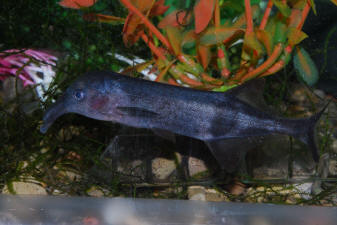
|
Cichlids sick? Env. and parasitic; and mormyrid beh.
9/28/17
Hi guys, so I was hoping you can help me. I have a planted 75 gallon
with a few small Tbar (sajica) cichlids, a small chocolate cichlid, a
small red Severum, a female electric blue Acara, a 4 inch ghost knife
(which is doing fantastic!! Swims all over the tank even during the day
and eats out of my hand!)
<Neato!>
and a Featherfin squeaker (I know, from a totally different part of the
world). This is NOT everyone's permanent tank. The T-bars (which are my
absolute favorite) are going in a 40 breeder I'm in the middle of
cycling.
My issue is this, I got the T-bars in the spring time at about 2/3
inches.
I had been looking everywhere to buy the T-bars but I couldn't find
anywhere that had them.
<Might have to order such "oddball" cichlids from the ACA (American
Cichlid Association) or regional Cichlid Club>
On a suggestion from a youtuber, I traveled out of state to a fish store
that actually had them. I really made a bad judgment call.
Sure enough, they had them, along with soooo many different fish and
fish I never heard of. Amazing, beautiful fish that were not kept in a
appropriate manner. I can't tell you how many tanks I saw that had
severely damaged fish. The tanks were just gross and while some were so
over populated, others only had one or two fish.. The T-bars tank was not
nearly as bad as others but foolishly I bought them and a chocolate
cichlid. The T-bars are barely growing, especially the male. It actually
looks like he's shrinking but his fins are getting super long and he's
grown the start of
his nuchal hump but he's small.
<Mmm; sounds/reads like they are stunted... from poor water quality,
crowding (chemical feedback), lack of nutrition>
The chocolate has had no issues and is growing as he should. I also
noticed that other two T-bars we're popping
white stringy stuff coming out of them constantly. Just like a long
string.
<Perhaps lumenal/intestinal parasite issue. Quite common with mixed,
imported fishes>
That went away but now occasionally I see the white stuff again although
not nearly as long.
<Mmm; search WWM re the use of Metronidazole here>
They and two of my other fish are flashing quite a bit.
My male Tbar that used to come out and eat anything he could, will only
eat live black worms, but still he isn't getting bigger at all! He
eagerly comes swimming over when I get in front of tank but won't eat
anything except the live food. I have a marine land canister filter 220
along with a Marineland penguin 400 hob filter. My ammonia is 0ppm,
nitrites 0ppm and nitrates are 20ppm. My pH is 7.2. I do weekly water
changes as well.
<Good>
Do you think it is a parasite?
<At least; yes>
If so what do I do?
<Lace the foods with Flagyl/Metro, or treat the water... maybe after you
move them to the 40
Read here:
http://www.wetwebmedia.com/fwsubwebindex/fwintparasitf.htm>
I am extremely nervous about losing my male Tbar as he is my absolute
favorite in the tank!! I feed them
a variety of food. Omega one flakes, Omega one shrimp pellets (for
catfish)
I put a European cucumber in every few weeks and the Severum and ghost
knife love it! I also feed frozen blood worms, frozen brine shrimp
(which I have recently learned isn't that great for them) and live black
worms
occasionally. Am I not feeding the right foods?
<I would sub Spectrum and Hikari pelleted for the Omega products>
Also, this has nothing to do with this but I have a elephant nose that I
have had for a couple years.
He is my absolute favorite out of all my tanks, because once again he
swims all over and eats from my hand. I just had a concern really. When
I got him when he was rather small, he had that white coloration they
all have on
their bodies but I have noticed for the past 8 months or so that the
white is almost gone. He has gotten significantly bigger and eats like a
pig. I just wanted to make sure if this was normal or if something is
wrong.
<Likely nothing wrong here; this color loss w/ age, growth is natural>
I really hope to hear from you soon with some suggestions. Thank you so
much!!
Jessica
<Welcome. Bob Fenner>
Elephantnose parasite treatment. Dis. and stkg f's
7/18/14
Hello,
I have greatly enjoyed your website, and have in fact found it so
comprehensive, and helpful I have never had to write until now.
I have a school of small Peter's Elephantnose fish in a
quarantine/holding 75g tank right now. In a couple days they will be
moving to moving to their final home, a 160g (+ big sump) tank, which
they will share with some Ropefish, Congo tetras, a pair of
Pelmatochromis Ocellifer, and later possibly an African knifefish, some
African Butterflyfish, and some other rarer West African cichlid and/or
Ctenopoma species. (I probably will add the fish on second half of the
list later, because for the next year or two
I'll be growing out a fire eel, an Astronotus crassipinnis (rare,
smaller cousin of the Oscar), a Paratilipia polleni, and some
Paretroplus maculatus
(hopefully) in the 160g before they move to the 300g tank. So that is
for the vision for the tank in the he next few years.)
I find Elephantnose fascinating, and that was my main motivation to
design a tank around them, and to keep them in a group like in nature. I
started out with nine, expecting that being a bit sensitive I might lose
one, and I have had them for two months now. I had one die for no
discernible reason not long after I bought them, but until a couple
weeks ago, all the others were fine. They were all eating very well on
live blackworms (rinsed well), frozen bloodworms, frozen Mysis,
frozen krill, and chopped earthworms.
During that first month most of them started to get nice and fat, and
lose that thin look they come in with, however a few kept getting
skinnier, even though they were eating well, and then eventually they
stopped eating as well, and got even skinnier, and then ate less...
etc., you get the picture. I am sure it is parasites, rather than
competition for food, because there are not other fish with them yet (I
wanted to get them
eating well before introducing them even to a sedate community tank) and
also because one of the very skinny ones was one of the largest, most
dominate of the ENs.
I hesitated to treat them all for parasites, because I know they are
sensitive to many meds, and I didn't want to risk the ones who were
healthy for the skinny ones. I eventually separated the two skinniest
ones to try to treat, but by that time they were too far gone and I lost
them. I want advice on what anti-parasitic to use on the six who are
left, because I really want to treat them all, just to be on a the safe
side. I have a couple still alive who aren't gaining weight like the
others. It is very similar to the "wasting disease" wild caught loaches
often come in with. I have available to use PraziPro, API General Cure
(Prazi and Metronidazole) and Levamisole. What would you recommend?
<The combination of the Praziquantel and Metronidazole... either as a
mixed product as you list from Aq. Pharm., or blended together
yourself... delivered via foods>
Also a separate question, but do you think I should add a couple
more Elephantnose once they are moved to the 160g? Six
seems to me to be on the low side for a group of them.
<Six is fine... and what I would stick with. As having more adds to the
possibility of the "last one" getting picked on, doing poorly>
Thank you so much, and sorry that it was a bit long!
--
*Ariel Johns*
<Cheers, Bob Fenner>
Re: Elephantnose parasite treatment
7/18/14
Thanks so much for the prompt reply!
Quick follow-up question: the API General Cure's instructions are for
mixing in the water, so what would be a good amount to use mixed with
the food?
<Mmm, IF you using the API in the water, realize almost NONE of it is
going to get inside the fish/es (FW fish don't drink their
environment... unlike marines). IN ORDER to treat for internal
parasites... Let's just have you read on WWM re:
http://wetwebmedia.com/FWSubWebIndex/fwmaintindex.htm
scroll down to Disease, read re the compounds involved here>
Each individual packet contains 250mg Metronidazole, and 75mg
Praziquantel. Should I mix one packet with water (how much water?), and
then soak their food in it? How long should I treat them with the
medicated food?
Thanks again!
<Do the reading. BobF>
|
Dolphin Fish, Mormyrid 1/17/14
Hello,
I want to start off by saying your forum has been quite helpful over
some of my fish keeping experience. I'm always seeking knowledge on new
fish species, diseases, and all of the above and always manage to come
across your website; which always seems very wise. I have a mountain of
questions for you, however I will try to make this as to the point as
possible now.
<Real good>
Anyways, a little over a year ago I came across the Mormyrid,
particularly the dolphin variety, and became infatuated.
<Neat animals; playful, intelligent>
I tried to gain as much knowledge on them as possible and a few months
later after being satisfied with my preparation, I started
searching for one. I looked over a year, came across a few iffy ones,
but was eventually surprised by my boss with two little dolphins waiting
for me at work (I work at a LFS.) I believe I ID'd them as Mormyrus
Kannume or Caballus, but who really knows?
<Closest is likely Fishbase.org as a taxonomic/identification resource>
I believe I have a respectable amount of knowledge on these fish now,
but was wondering if you could fill in the gaps for me, if possible. I
was given 2 dolphin at around 2" at most, one clearly more dominant than
the other. I took them both with plans to eventually either have them in
separate tanks or at least "beef" up the weaker of the two with good
care and a good diet so it was stronger for it's next home.
I've had them since the end of November and they are both still alive,
the larger being closer to 4" (at least) and fat now, and the lesser
being just slightly larger than before but the same weight except at
feeding time when they both get big round bellies. They have both been
extremely active and seem to be the happiest fish all the time. They're
in such good spirits, they volunteered to go right in my net for me when
I caught them while planting their tank for them. Very interesting fish
indeed.
<Attracted to the metal likely>
My set up: 37 gallon tall (grow out tank)Trying my hand at a planted
tank Substrate is 1/2 soft soil (Mr. Aqua Water Plant Soil)
<Good>
with gravel underneath (chose to reverse substrates and not cap for
dolphins delicate noses) and the other 1/2 is fine natural colored sand.
Driftwood with java moss attached rock cave Hairgrass3 sword plants3
bundles of mixed plants1 moss ball
Temperature is kept on the warm side between 80-82F degrees50g sponge
filter (though might be changing filtration soon) Additional airstone in
sand
4 apple snail tank mates, 1 egg sac currently present at the surface. 3
Otocinclus (just added)1 Dwarf Gourami (just added)
Dolphin Diet (fed before bed time, but will eat any time of the
day):Live black worms (cleaned nightly)
Frozen bloodworms
Frozen Daphnia
Will not touch: Any pellets (of course)Frozen brine shrimp
Water changes were weekly/bi weekly 25%-45% but these guys seem to
have an issue with either my tap or my dechlorinator (SeaChem prime) so
against my nagging desire to be fastidious, I've lowered the water
changes to when it's needed since the planted tank seems to take care of
a lot on it's own.
<Best to store all make-up, change-out water for a week or more ahead of
time of use>
I'm looking into getting an RO system at home to fix this dilemma for me
so I can clean more often without worrying about irritating the fish.
<Good>
I have added 3 Otocinclus (monitored for sucking on other fish) to clean
the algae and 1 dwarf Gourami to get the bugs since apparently these
things are more common in planted tanks. After reading about dwarf
gouramis on your page though, I'm rethinking my pest control choice. I
also starting dipping my plants in hydrogen peroxide before adding since
I thought this was a better choice than bleach.
<Alum is even better... search the Net, books re its use here>
Water parameters currently: Temp: 82-83F, it's a bit warm here in
California
<Not to worry. Periodic forays into the upper eighties F. are not a
problem>
PH: 6.8 ish NitrIte: 00ppmNitrate: 20ppmAmmonia: 00pmKH: 40ppmGH: 180ppm
My questions for you:*What other food options can I do for these fish?
<Anything "meaty" of size... e.g. Tubificids... frozen/defrosted better
than live; may take some dried>
And has their nutrition been met so far or do I need to add something
else? *What is the average breathing rate of these fish? I've noticed
since day 1 that they seem to breath extremely fast. Should I consider
this their normal rate, or is this something I should have been paying
attention to?
*Are there dechlorinators that are known to be better for these types of
fish?
<Mmm, yes... the Kordon (NovAqua, Amquel) and SeaChem product lines are
my choices>
I do not have the option of having my water sit for a week before adding
it to the tank. Nor is it practical for me to have 20 gallons premixed
and then added to the tank as I'm a 5'1 female and am battling chronic
health issues.
<Ahh, understood... and sorry for your health issues. The RO mixed will
help tremendously here>
*Will these fish be ok if supplements are added correctly? i.e. adding
SeaChem Flourish and/or excel? *Will adding pressurized C02 be ok if I
had an indicator monitoring it?
<These additions; as you state, added properly, will be fine>
*I noticed the dolphins being a bit lazier, not swimming wildly (but
happily) around the tank all the time. Is this due to comfort?
<Are fine; "happy" as you state, when out and about searching, curious
re their world, interacting w/ each other>
The smaller hides when it can and usually only comes out when being
chased or when it's dinner time, but the larger isn't as ruthless and
chasing the smaller so often, so it's not showing itself as often. The
larger one, and one I can see resting since it's too large to hide under
things, is still active and noses through the soil quite often. It has
bursts of energy or times of the day, but I see it resting on the bottom
sometimes now. This might be normal for most fish to "nap" but I've not
seen this much before now with them. It is possible they are growing
more accustom to me and don't swim erratically when I come to watch them
now, but I'm unsure if it could be something more serious. The larger
dolphin used to tear at the smaller one's fins all the time, but now
they're completely healed and intact. Is this mercy or a sign of more
ominous issues occurring in the tank?
<Mormyrids often don't "get along" in the same, smaller volumes... will
do so temporarily if crowded... You may find that the larger one will
calm down if given a "shelter"... can be a tube of PVC, glass chimney or
such (i.e. clear/transparent) or not. Otherwise; best to have these fish
in two separate systems>
Attached are some photos.#1-week 1 of having them both#2-12/14 of larger
dolphin#3-today, larger dolphin. excuse the water spots#4-today, larger
dolphin#5-today, larger dolphin. Most important to show, I noticed some
dark spots on the fins of this fish. There is no ammonia present, but I
also just did a water change 2 days ago. The white specs seen are not on
the actual fish but on glass (hence the Gourami, still getting used to
the critters associated with more planted tanks) this is the "resting" I
was speaking about.
Thank you for your time and patience reading through this, I wanted to
be thorough as possible. I've got a 125g and a 240g as well and these
are just my babies. It took so long to get them and I want to make sure
they are cared for properly, though I'm a bit overbearing when it comes
to these two. Looking forward to hearing from you.
Have a great night! Lauren Saunders
<Thank you for sharing. Bob Fenner>
|
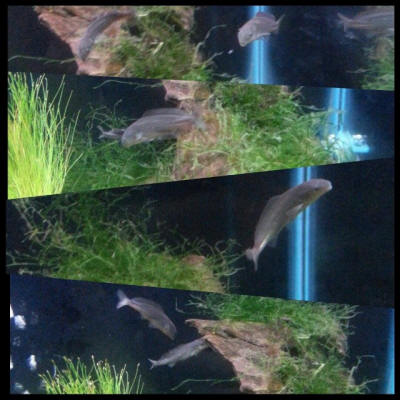
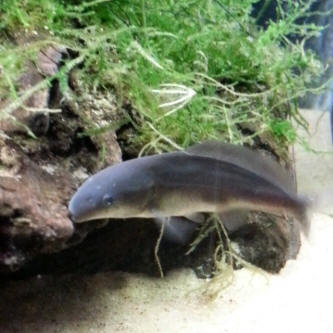
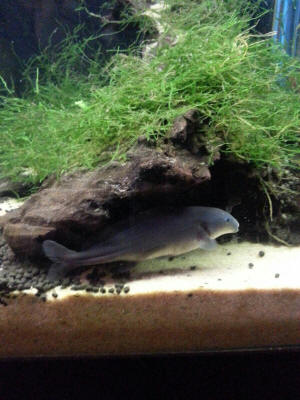
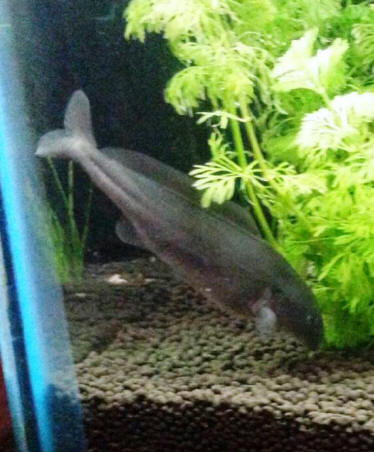 |
Mormyrids... Stocking tog., beh.
2/7/12
If Mormyrids are crowded, does this bring out a different behavior that
is sustainable and can they put up with the presence of many other
Mormyrids in close proximity without being stressed by each others
fields?
<Does seem to be the case in retailers' tanks'¦ but
whether sustainable long-term at home, I cannot say. Would not
recommend overcrowding any fish as sensitive as these.>
Does this video show there is a benefit to crowding them, and they are
adapted to put up with large groups of their own kind, like with
Tropheus?
http://www.youtube.com/watch?v=c6lcpt6dICI
<And even with Tropheus, there are huge problems with
nitrate-sensitivity, filtration.>
The person who has that tank said that out of the Mormyrids he has
Campylomormyrus tamandua is not very aggressive in groups, is that well
known to be true?
<The species is not commonly kept, so it's hard to say. Baensch
describes them as "peaceful loners" and comments that in
groups bigger ones bully the smaller ones, preventing feeding. So your
problem may be a long time in coming, with fish seemingly coexisting
for weeks, months until the weaker ones starve.>
Also wonder what the guidelines are for Petrocephalus, they are
schooling and small so how much room and how big a school is needed to
keep them. And they still need pvc pipes to hide from each other? Is a
3' tank too small for a school of Petrocephalus, will they
eventually breed and kill each other in that size tank?
<Would treat as any other medium-sized, delicate schooling fish,
such as Glass Knifefish. Oversized tank, oversized filter relative to
their size. Get the tank up and running for some months before
introduction. Maintain with peaceful tankmates selected to play the
role of dither fish (surface-swimming Rasboras or Danios for example)
rather than anything midwater or benthic. A tank upwards of 55 gallons
with a filter rated at not less than 8 times the volume per hour would
seem prudent. As with all Mormyridae, the more caves, tubes, robust
plants the better. Although gregarious, that doesn't mean this
species "likes" its own kind -- just as with any schooling
fish, even Danios, the stronger will be bullying the weaker, albeit
rarely to the point of death. Rather than keeping 6, aim to keep 10 or
12.>
-Jacob
<Cheers, Neale.>
Re: Mormyrids 2/9/12
Why are Mormyrids so sensitive to chemicals and metals, in a way most
other fish aren't?
<They just are. All fish are sensitive to copper and formalin and
suchlike.
But some are more sensitive than others, and Mormyridae are at the very
sensitive end, like Stingrays.>
I know they're stress prone and aren't treated properly
usually, but the water issues, is their one trait that makes Mormyrids
so frail in that way?
<Pretty much everything about them is demanding.>
The article on them on WetWebMedia says to treat tap water and let it
stand for a weak, ideally. Is there a tap water test to tell you if
your tap water is likely to kill them?
<Water chemistry actually doesn't matter much. So your issues
are ensuring copper and ammonia are neutralised, as well as the usual
chlorine and chloramine. Mormyridae aren't killed so much by bad
water as bad water quality.>
It seems like there are many possible ways for that to happen, so
I'm curious as to why.
<Just is. Cheers, Neale.>
|
Longnose elephant nose behaviour 9/13/10
Hi!
<Ave!>
Two months ago I purchased a Longnose elephant nose from the LFS
I work at.
I was a customer there for a few months and I noticed that
Longnose elephant noses (sold as Double-Trunk Elephant Noses)
were much more skittish and sensitive than the common elephant
nose.
<Possibly; none of the Mormyrids is an "easy"
fish.>
The two LNEN that I saw hid all day, rarely came out of hiding
for feedings and died after a month. When I started working
there, there was one that I saw that I was debating getting. This
one wasn't as nervous and even came out of hiding one day
while I was looking in the tank. He did eat as much as he could
(before other fish ate the food), but was very easily
startled.
After maybe 3 weeks, I bought this one.
<Okay.>
So now he is eating a bit more comfortably, but still easily
startled. He actually comes out and swims around in a circle
before retreating to his cave to let me know he is hungry. If I
walk over to the tank to look at him, he hides though.
<Well, yes, does tend to be their nature. They're
nocturnal fish, and any activity during the day only happens when
they feel completely settled. One issue is that in large groups
these Mormyrids are schooling fish, but once
kept singly they become much more nervous, like a single Neon
tetra. The flip side is that within small groups, 2-5 specimens,
bullying is very common, and the dominant specimen often kills
the others, or at least, bosses them around.>
At work, when we get large common elephant noses they quickly
learn to come up and eat right from the turkey baster (used to
spot feed). Many trade-ins are the same way.
<Indeed. Gnathonemus petersii is a fairly aggressive, pushy
species by Mormyrid standards, and I dare say that this is the
reason why this species alone is regularly traded.>
So, finally what I would like to know is, are these elephant
noses normally much shyer than common elephant noses?
<Apparently yours are. Campylomormyrus are not widely traded,
so it's dangerous to make generalisations. But there may well
be some behavioural differences that mean these species adapted
less well to captivity than the
commonly traded Gnathonemus petersii.>
Also, how long does it normally take them to be comfortable
enough not to hide as soon as they see you?
<Impossible to say. A lot will depend on the tank. In a large,
shady aquarium in a quiet room and decorated with a soft
substrate, floating plants, and a few surface-swimming dither
fish, I'd expect yours to settle within a few weeks. But in a
tank that's too small, in a noisy room, with a gravel or
sharp sand substrate, boisterous tankmates, or unfiltered
overhead light, it could take much longer, if it ever happens at
all.>
Finally, I would like to confirm an ID. I believe that mine is a
Campylomormyrus rhynchophorus based on what I seen on Fishbase
and in Dr. Axelrod's Atlas of Aquarium Fishes. Only
difference is mine seems to have a less deep body and larger
eyes. I will attach a picture.
<Do please note for next time that we ask for images around
500 KB in size, whereas yours was 5 MB. Such big files quickly
fill up our e-mail allowance, bouncing back other people's
messages unread. In any case, your
specimen is certainly a Campylomormyrus of some sort, but there
are several look-alike species such as Campylomormyrus cassaicus,
Campylomormyrus elephas, Campylomormyrus rhynchophorus and
Campylomormyrus tamandua it could very easily be. They're all
much of a muchness, though adult size varies from 20-40 cm. Soft
to moderately hard, slightly acidic to neutral water at about 24
C/75 F suits them well.>
Thank you very much for your time! Tyler
<Cheers, Neale.>
Reply to old answer, Mormyrid beh. 1/25/11
Hi, a while ago I was asking you guys for some tips on my
extremely shy Campylomormyrus rhynchophorus.
<A very unusual Elephantnose
fish'¦ a nice find!>
It's been a couple months, and he/she has become extremely
comfortable in his/her aquarium and now is always out and will
even eat out of my hand.
<Excellent. Yes, Elephantnoses can become very tame, and once
tame, are easier to feed than when first purchased. They are
supposedly among the most "brainy" fish and their
behaviour in captivity is often remarkably trusting and
playful.>
I bought a large Anubias sp. plant that fills the tank from
corner to corner and have a layer of duckweed on the top and I
feel the lack of wide and open spaces in the tank makes the fish
feel more comfortable.
<I would agree 100%. While many aquarists see Duckweed as a
pest, it can be hugely useful in tanks where the fish dislike
bright light.>
This isn't a question, but just my experience with the fish
and I hope it helps you guys out.
<Thanks very much for sending this along.>
And thanks for the great website! It is definitely one of my top
sources when deciding on fish!
<Glad you enjoy the site, and thanks for the kind words.
Cheers, Neale.>
|
 |
|
Aggression in elephant nose fish 7/26/08 Hi! I just have a
quick question. I was wondering if you could explain the
difference between "playing" and aggression in elephant
nose fish. <Gnathonemus will play with novel objects, like
tinfoil balls; they fight with one another.> I understand they
are more active at night, but we have one that won't leave
another alone. <Aggression.> He even goes after the smaller
fish in the tank. He is the newest addition, and Im actually
starting to regret him. I don't want another at the first
ones expense! <Gnathonemus petersii is a species that should be
kept either singly or in big (6+) groups. What you're doing
almost never works, and the weaker fish will eventually die.>
Thank you in advance. <Sorry can't offer any more positive
advice. This is a difficult species at the best of times, well
known for intraspecific aggression, much of which involves
bullying via electrical fields, so is invisible to us. Either
separate the fish or add more, similar sized specimens. Cheers,
Neale.>
Re: aggression in elephant nose fish 7/26/08 Thank you
so much for your quick reply! I guess the next questions would
have to be: I currently have a 50 gallon tank. Would it be safe
add 2 and make it a group of 4? <Depends on how heavily
stocked the tank is otherwise, and how big these Gnathonemus are.
Adult size in aquaria seems to be around 20-25 cm, though
potentially a bit bigger in the wild. I'm not convinced that
4 will fix the problem, but if you want to give it a whirl...>
I think 6 would be way too much. <Not for this species. The
problem is that they generate electric fields, and there is a
optimum frequency that works best. The dominant fish will bully
the other ones to force them to use less good frequencies.
Moreover, simply being in the same tank is sort of like having
the fish shouting at each other all the time -- tempers get
frayed! In the wild they form big schools (dozens, if not
hundreds, of specimens) but in aquaria this stable population
structure doesn't occur.> And if I shouldn't add more,
the only other tank we currently have going is a 25 gallon which
is already home to a transparent knifefish. If I had to separate
them would that be a suitable home for my new elephant nose or
should I continue looking for a new home for him??? <I'm
assuming the Glass Knifefish is Eigenmannia virescens -- another
electric species! You'll get precisely the same problem with
one bullying the other.> Once again thanks a million! Rachel
<Hope this helps, Neale.>
|
|
|

